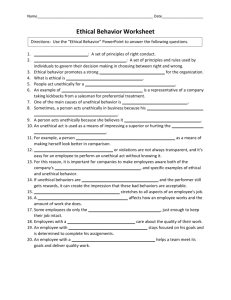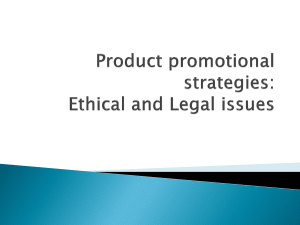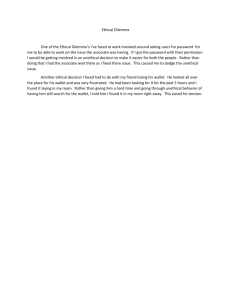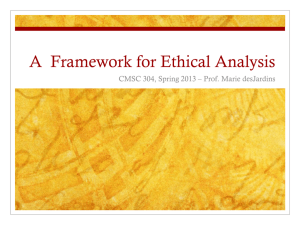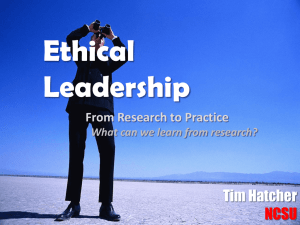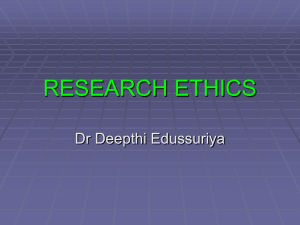Ethical Blind Spots - University of New Mexico
advertisement
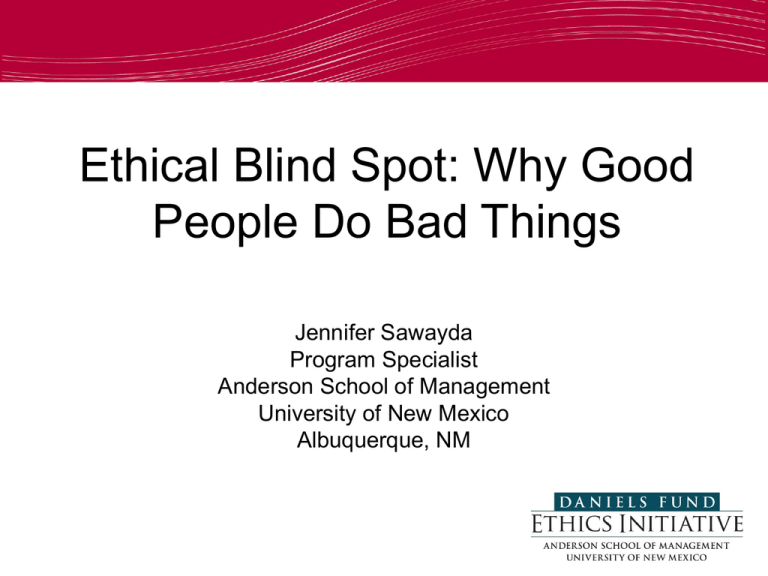
Ethical Blind Spot: Why Good People Do Bad Things Jennifer Sawayda Program Specialist Anderson School of Management University of New Mexico Albuquerque, NM Myth #1 • Most misconduct in organizations is done by ‘bad apples’ or rogue employees seeking to take advantage of the situation – This assumption takes for granted that individual moral values & philosophies are the primary tools used in employee ethical decision making. – Takeaway, ‘hire good people & there will be no ethical issues’ Reality* • Most individuals see themselves as being ethical. – In one survey, respondents were asked to rate how ethical they felt they were compared to the rest of the population on a scale of 0 (completely unethical) to 100 (completely ethical) – The average score was 75 – The majority see themselves as more ethical than their peers * Max Bazerman & Anne Tenbrunsel (2013) Blind Spots: Why We Fail to Do What's Right and What to Do about It, Princeton University Press. Question • If most individuals rate themselves as ethical & perceive that they have higher moral values—even more so than their peers—why is misconduct so prevalent? Ethical Decision Making Model* *O.C. Ferrrell and Larry Gresham (1985) Journal of Marketing. Theories of Human Behavior • Standard economic model – Unbounded power, unbounded rationality, & unbounded selfishness – People will act deceptively if it is in their own selfinterest • Employees learn from others in the company – Social learning theory-people learn behavior by observation, modeling, & interaction with others – Differential association theory-people learn to behave a certain way based on interaction with intimate groups or role sets Implications • While an employee might desire to be ethical (individual values), social and situational factors in the workplace exert significant pressure on the employee (organizational relationships, opportunity) Barriers to Ethical Culture* 1. 2. 3. 4. 5. Poorly-conceived goals Motivational blindness Indirect blindness The slippery slope Overvaluing performance/outcomes * Max Bazerman & Anne Tenbrunsel (2013). Poorly-Conceived Goals • Setting ambitious—sometimes unfeasible— goals without considering how these goals will be carried out – “I don’t care how you make the numbers as long as you make them!” – Countrywide Financial; Ford Pinto defects; Challenger Explosion Motivational Blindness • When a conflict of interest exists, employees are encouraged to ignore unethical behavior – ‘As long as the company is doing all right in the long-run, manipulating this quarter’s numbers won’t make much of a difference.’ – Enron’s Jeffrey Skilling & Ken Lay; Arthur Anderson; Penn State; WalMart & bribery in Mexico Indirect Blindness • Less of an ability to see actions that indirectly harm others as unethical or wrong – A sales manager hints to a new salesperson that the best way to sell a controversial drug is to avoid mentioning certain side effects – Milgram experiments; Nike & child labor Slippery Slope • Employees are less likely to notice unethical behavior when it happens gradually, or in increments – The boiling frog scenario – Many frauds start out this way: “Just one more time and then we’ll stop,” Weston Smith, former CFO of HealthSouth Overvaluing Performance • The outcomes are more important than what it took to get those outcomes. • The ends justifies the means – “Getting tips from the inside has doubled our company’s profitability,” The Galleon Group; Diamond Foods Conclusions • Being aware of social & situational influences in the workplace can prepare us for discovering & resolving ethical issues • Companies can help through: – – – – Ethics training & codes Ethical leadership within the organization Controls to limit opportunity for unethical behavior An open communication culture encouraging employees to speak up – Hotlines & anonymous reporting mechanisms
